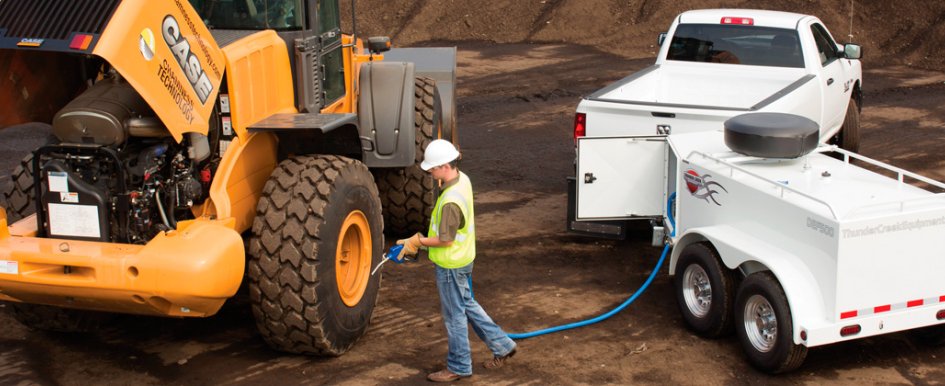
Diesel exhaust fluid (DEF) is not new to the construction industry. In fact, the first heavy construction equipment with DEF was introduced almost 5 years ago. On-road trucks with selective catalytic reduction (SCR) have been in use for quite some time. However, a new aspect to consider is the quantity of DEF currently in demand and the influx of equipment hitting the market that requires DEF. According to industry estimates provided by the Integer Emissions Summit and DEF Forum, DEF demand will more than triple, to 1.8 billion gallons, between now and 2025. A large percentage of that increase can be attributed to new, Tier 4 Final equipment in the construction and agriculture industries.
Manufacturers of high-horsepower diesel engines, specifically those with 75 horsepower and greater, are using SCR systems to meet emissions regulations. SCR is an aftertreatment technology that sprays DEF into the engine exhaust via a dosing mechanism. This produces a chemical reaction with nitrogen oxide (NOx), converting it to water and nitrogen (completely inert) before releasing it through the equipment's exhaust pipe.
Where & How to Purchase DEF
Determining which DEF vendor to work with is as simple as checking labels and making sure you have got the right type of container to hold the fluid. DEF is commonly sold in jugs, 55-gallon drums, 275- or 330-gallon intermediate bulk container (IBC) totes and in bulk. Contractors should always make sure that the fluid they are purchasing meets the ISO standard (ISO 22241).
Secondly, they should always use a container made specifically for DEF, constructed with materials approved in the ISO standard, and sterilized and sealed properly. While the ISO standard allows for open systems when storing DEF, a number of OEMs and industry experts suggest that a closed fluid path solution is the most practical and effective.
The challenge with open systems is that the container must be sterilized between each use, which is not always practical in construction environments. A closed system—where the DEF is never exposed to the elements up until the very moment it is pumped into the machine—further ensures fluid purity and machine health.
These systems can be outfitted on more simple storage and handling solutions, such as an ISO-compliant, 50-gallon DEF tote. There are also dedicated ISO-compliant DEF trailers and DEF storage and pumping systems built into larger fuel and service trailers on the market.
Furthermore, 2-in-1 pumping systems are available with these solutions, which allow DEF to be seamlessly pumped into and out of containers without having to switch to another pump—simplifying the footprint and the hassle of these systems.
Contractors should never mix their own DEF or use small jugs and containers that have been used to store other fluids previously. The use of older, non-dedicated containers significantly increases the opportunity for DEF contamination.
Care should also be given when filling the DEF tank from a smaller container via a funnel, as any other dirt, grease or fluids previously poured through that funnel can contaminate DEF. The DEF fill area on each machine should be kept as clean as possible to prevent possible contamination when a DEF nozzle is inserted into the machine.
Why Is DEF Purity Important?
DEF is always comprised of 67.5 percent deionized water and 32.5 percent automotive-grade urea. This colorless fluid is not hazardous, but it is highly sensitive to chemical impurities and is corrosive to certain metals, such as steel, iron, zinc, nickel, copper, aluminum and magnesium. Maintaining the integrity of DEF is imperative in order to properly protect Tier 4 engines.
As little as 1/10 of a teaspoon of many common elements is enough to bring an entire 5,000-gallon tank of DEF off-spec, according to the ISO 22241 standard.
These contaminants include copper, zinc, chromium, nickel, iron, aluminum, phosphorous, magnesium, calcium, sodium and potassium. Even something as simple as tap water can bring DEF off-spec. Contaminated DEF can cause any number of problems with today's SCR systems, including:
- Increased DEF consumption in equipment
- Loss of its effectiveness to remove nitrogen oxide from engine exhaust
- Malfunctions with the SCR system
- The engine de-rating or shutting down
- Damaged equipment
- Voiding of the manufacturer's warranty
Equipment using contaminated DEF will consume more fluid and be less effective at reducing emissions from the exhaust. Most importantly, contamination will damage the catalyst in the SCR system over time, which could potentially cause the engine to shut down and leave the machine idle. There are several engine manufacturers now stating that they will opt to decline warranty claims if the damage is tied back to contaminated DEF.
Shelf Life of DEF
Prolonged exposure to direct sunlight and high temperatures will cause DEF to degrade. DEF retains its full quality for 36 months when stored at or under average temperatures of 50 degrees Fahrenheit. This reduces to 18 months at 77 degrees, 12 months at 86 degrees and just 6 months for DEF that is consistently exposed to temperatures above 96 degrees.
There are also risks to storage containers and pumping systems if the temperature drops too low (although freezing does not have a negative effect on DEF itself). DEF freezes at 12 degrees, so follow the below guidelines for colder climates:
- DEF expands by approximately 7 percent when frozen. Prevent fully filled, closed containers and pumping systems from freezing, as this can cause damage. This is another benefit of 2-in-1 pumping systems, as DEF can be easily purged back into the tank after filling the machine.
- Be sure DEF is completely thawed before use.
- Do not use additives to prevent freezing.
Heating elements can also be added to DEF totes and trailers to prevent DEF from freezing when working in cold weather climates. When DEF is handled properly, there is absolutely no risk to machinery health or performance. By handling DEF in ISO-approved containers and with consideration to environmental conditions, equipment owners will ensure that SCR-based, Tier 4 engines and systems experience optimal uptime and productivity.
